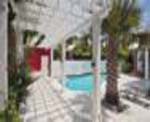
Courtesy of: W. Christian Busk
Lush Landscapes
Going green, one of the today’s hottest trends, has been applied in businesses, buildings, homes, appliances, product packaging and much more. But perhaps the most sensible place to utilize environmentally friendly tactics is on the earth itself—in our landscapes.
To do that, homeowners are opting for plants native to Southwest Florida that are less-taxing on the soil and water supply.
"Plants that are indigenous to Florida require less water, which in turn requires less fertilizer," says Brian Thompson, owner of Procut Lawn Care and Landscaping. "Too much fertilizer seeps down to the water table, thus affecting our water quality."
But preserving our natural resources does not mean sacrificing style and design, say local landscape architects.
"What we are seeing here is a transition from a controlled landscape to a more natural landscape," says Richard Tindell, partner of J. Roland Lieber Landscape Architecture.
From serene Asian-inspired respites to expansive views that extend all the way to the Gulf, landscape designers take the notion of paradise to an entirely new level.
"If [a landscaped scene] is done at its best, it would seem like it could not be any other way, like an impeccably dressed woman," Tindell says. "Nothing about her look seems contrived."
Feast your eyes on these naturally beautiful landscapes we found throughout Southwest Florida.
Zen Escape
Ideal for quiet meditation, yet large enough to host a party, this Sanibel home’s outdoor space, created by W. Christian Busk, pairs sleek Japanese-inspired design with Florida native palms and greenery.
Secret Gardens
"There is a movement away from tried and true plant materials and the standard palette," says Ellin Goetz, of Goetz+Stropes Landscape Architects. "Clients are more open to suggestions we make which are always ahead of what is standard." Opposite, a secluded spot is perfect for a secret t�te-�-t�te. Above, builder Porter VanArsdale Construction paired clean, crisp design with Goetz+Stropes’ selective use of greenery. Left, a wisteria-covered arbor invites visitors for a casual stroll through this thriving garden.
Wild life
To create a complete scene, the landscaping needs to go beyond greenery. It can include majestic or even whimsical statues that reflect the homeowners’ personal tastes, such as this bronze panther fountain in a Port Royal home, with landscape designed by W. Christian Busk.
Pop of Color
Florida’s lush foliage isn’t restricted to green. These red impatiens grow abundantly in a shady, moist spot in Port Royal.
Soak it in
This Port Royal yard, designed by W. Christian Busk, blends effortlessly with its natural surroundings. Foxtail palms, perfectly coifed lawn and potted geraniums surround an infinity edge pool—all of which overlook Naples Bay.
Beyond Plants
While much of the excitement of planning an outdoor space is centered on the living elements—annuals, perennials, trees and bushes—the finishing touches of solid and fluid surfaces, known as the hardscape, complete the landscape’s overall look while adding an element of drama and even surprise.
"There are so many facets to landscaping," says Richard Tindell, partner of J. Roland Lieber Landscape Architecture. "A lot of people think of trees and bushes and tiki torches, but it is so much more like walkways, flags, fountains that are gurgling, leaves and palm fronds."
Hardscapes include paths, trellises, driveways, retaining walls, pools, decks and fountains. Stones and boulders can add substance to the design, but they require careful placement to blend naturally with the plants, and not look like they’ve just been plopped in the middle of the yard. Try "planting" a boulder a few inches in the ground to make it appear as if it’s been there for decades.
Water features are making a comeback, Tindell says. "You can use water to reduce traffic noise or give a feeling of coolness."
Don’t limit your imagination. Incorpor-ate natural-rock waterfalls, statuesque fountains and rock-lined koi ponds.
